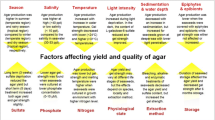Abstract
Apple shoots were grown in a Murashige and Skoog liquid proliferation medium containing 4.4 10 -6 M BA, and supplemented with various fractions of agar. Hydrolysed agar from Difco was able to overcome hyperhydricity when its concentration was increased to 0.7%. Among the fractions isolated from this hydrolysed agar, only oligosaccharides were found to reduce the occurrence of this developmental abnormality. The most anti-hyperhydric fraction had a molecular weight slightly less than 1900 daltons and contained methylated and sulphated galactose derivatives.
Similar content being viewed by others
References
Albersheim P, Darvill AG, Mc Neil M, Valent B, Sharp JK & Coll (1983) Oligosaccharins, naturally occurring carbohydrates with biological regulatory functions. In: Ciferri O & Dure L III (eds) Structure and Function of Plant Genomes (pp 293–312). New York, Plenum
Bornman CH & Vogelmann TC (1984) Effect of rigidity of gel medium on benzyladenine-induced adventious bud formation and vitrification in vitro in Picea abies. Physiol. Plant. 61: 505–512
Brand MH (1993) Agar and ammonium nitrate influence hyperhydricity, tissue nitrate and total nitrogen content of serviceberry (Amelanchier arborea) shoots in vitro. Plant Cell Tiss. Org. Cult. 35: 203–209
Daguin F & Letouzé R (1986) Ammonium induced vitrification in cultured tissue. Physiol. Plant. 66: 94–98
Debergh P (1983) Effect of agar brand and concentration on the tissue culture medium. Physiol.Plant. 59: 270–276
Debergh P, Harbaoui Y & Lemeur R (1981) Mass propagation of globe artichoke (Cynara scolymus): evaluation of different hypotheses to spelling overcome vitrification with special reference to water potential. Physiol. Plant. 53: 181–187
Debergh P, Aitken-Christie J, Cohen D, Grout B, Von Arnold S, Zimmerman R & Ziv M(1992) Reconsideration of the term “vitrification” as used in micropropagation. Plant Cell Tiss. Org.Cult. 40: 135–140
Druart P, Boxus P, Liard O & Delaite B (1981) La micropropagation du merisier à partir de la culture de méristème. In: Proceedings IUFRO, In vitro Cultivation for Trees Species, (pp 101–108). Fontainebleau (France)
Dubois M, Gilles KA, Hamilton JK, Rebers PA & Smith F (1956) Colorimetric method for determination of sugars and related substances. Anal. Chem. 28: 350–356
Garcia-Romera I & Fry SC (1994) Absence of transglycosylation with oligogalacturonides in plant cells. Phytochemistry 35: 67–72
Jones TM & Albersheim P (1972) A gas liquid chromatographic method for the determination of aldose and uronic acid constituents of plant cell wall polysaccharides. Plant Physiol. 49: 926–936
Maas FM, Hoffman I, Van Harmelen MJ & De Kok LJ (1986) Refractometric determination of sulphate and other anions in plants separated by HPLC. Plant Soil 91: 129–132
Marga F, Priem B & Morvan H (1990) Effets stimulateurs des oligogalacturonates sur l'excrétion de polysaccharides acides par la suspension cellulaire de Silène. Can. J. Bot. 68: 1833–1839
Pâques M & Boxus P (1986) Methode et composition de lutte contre le phénomène de vitrification au cours de la micropropagation in vitro des plantes. Brevet belge: 904661, Eur. Patent: 0247018, US Patent 07-041427
Pasqualetto PL, Zimmerman RH & Fordham I (1988) The influence of cation and gelling agent concentrations on vitrification of apple cultivars in vitro. Plant Cell Tiss. Org. Cult. 14: 31–40
Pochet B, Scoman V, Mestdagh MM, Moreau B & André P (1991) Influence of agar gel properties on the in vitro micropropagation of different clones of Thuja plicata. Plant Cell Rep. 10: 406–409
Priem B & Gross KC (1992) Mannosyl-and xylosyl-containing glycans promote tomato (Lycopersicon esculentum Mill.) fruit ripening. Plant Physiol. 98: 399–401
Rees DA (1969) Structure, conformation and mechanism in the formation of polysaccharide gels and networks. Adv. Carbohydrate Chem. Biochem. 24: 267–332
Singha S (1982) Influence of agar concentration on in vitro shoot proliferation of Malus sp.' Almey' and Pyrus communis 'seckel'. J. Amer. Soc. Hort. Sci. 107: 657–660
Yaphe W & Arsenault GP (1956) Improved resorcinol reagent for the determination of fructose and 3-6 anhydro-galactose in polysaccharides. Anal. Biochem. 13: 143–148
Ziv M (1991 a) Quality of micropropagated plants-Vitrification. In Vitro Cell Dev. Biol. 27: 64–69
Ziv M (1991 b) Morphogenic patterns of plants micropropagated in liquid medium in shaken flasks or large-scale bioreactor cultures. Israel J. Bot. 40: 145–153
Author information
Authors and Affiliations
Rights and permissions
About this article
Cite this article
Marga, F., Vebret, L. & Morvan, H. Agar fractions could protect apple shoots cultured in liquid media against hyperhydricity. Plant Cell, Tissue and Organ Culture 49, 1–5 (1997). https://doi.org/10.1023/A:1005832115954
Issue Date:
DOI: https://doi.org/10.1023/A:1005832115954




